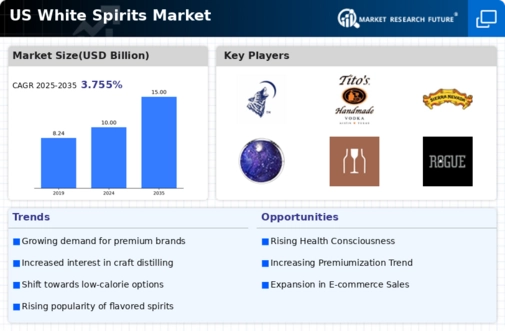The white spirits market exhibits a dynamic competitive landscape characterized by a blend of innovation, strategic partnerships, and regional expansion. Key players such as Diageo (GB), Pernod Ricard (FR), and Bacardi (BM) are actively shaping the market through their distinct operational focuses. Diageo (GB) emphasizes innovation in product offerings, particularly in the gin segment, while Pernod Ricard (FR) pursues aggressive regional expansion strategies, particularly in North America. Bacardi (BM), on the other hand, is concentrating on sustainability initiatives, which resonate well with the evolving consumer preferences towards environmentally friendly products. Collectively, these strategies contribute to a competitive environment that is increasingly focused on differentiation through quality and brand loyalty.
The business tactics employed by these companies include localizing manufacturing and optimizing supply chains to enhance efficiency and responsiveness to market demands. The competitive structure of the market appears moderately fragmented, with several key players holding substantial market shares. This fragmentation allows for a diverse range of products and brands, fostering competition that drives innovation and consumer choice.
In October 2025, Diageo (GB) announced a significant investment in a new distillery in the U.S., aimed at increasing production capacity for its premium gin brands. This move is strategically important as it not only enhances Diageo's operational capabilities but also aligns with the growing consumer trend towards premiumization in the spirits sector. By bolstering its production capacity, Diageo positions itself to better meet the rising demand for high-quality spirits.
In September 2025, Pernod Ricard (FR) launched a new digital marketing campaign targeting younger consumers, leveraging social media platforms to enhance brand engagement. This initiative underscores the company's commitment to digital transformation and reflects a broader trend within the industry to connect with a tech-savvy demographic. By utilizing innovative marketing strategies, Pernod Ricard aims to strengthen its brand presence and drive sales growth in a competitive market.
In August 2025, Bacardi (BM) unveiled its new sustainability program, which includes a commitment to reduce carbon emissions by 50% by 2030. This initiative is particularly relevant as consumers increasingly prioritize sustainability in their purchasing decisions. Bacardi's proactive approach not only enhances its brand image but also positions the company as a leader in corporate responsibility within the spirits industry.
As of November 2025, the competitive trends in the white spirits market are increasingly defined by digitalization, sustainability, and the integration of advanced technologies such as AI. Strategic alliances among key players are shaping the landscape, facilitating knowledge sharing and resource optimization. Looking ahead, competitive differentiation is likely to evolve from traditional price-based competition towards a focus on innovation, technological advancements, and supply chain reliability. This shift indicates a growing recognition that long-term success will depend on the ability to adapt to changing consumer preferences and market dynamics.























Leave a Comment